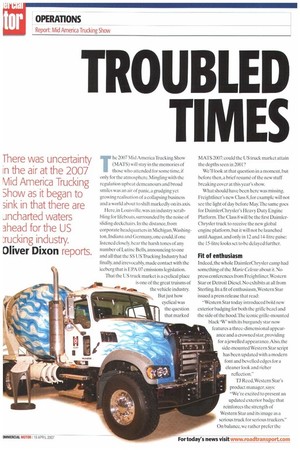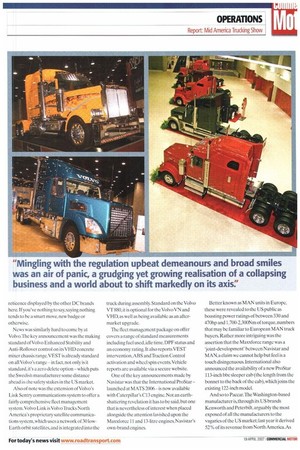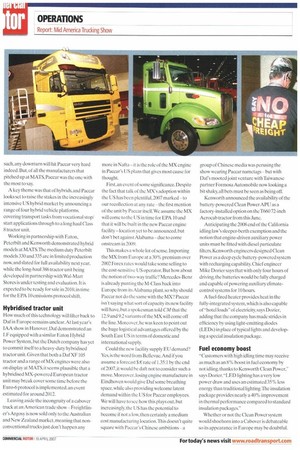TROUBLED TIMES
Page 76

Page 77

Page 78

Page 79

If you've noticed an error in this article please click here to report it so we can fix it.
There was uncertainty in the air at the 2007 Mid America Trucking Show as it began to sink in that there are Jncharted waters ahead for the US trucking industry.
Oliver Dixon reports.
The 2007 Mid America Trucking Show (MATS) will stay in the memories of those who attended for some time, if only for the atmosphere. Mingling with the regulation upbeat demeanours and broad smiles was an air of panic, a grudging yet growing realisation of a collapsing business and a world about to shift markedly on its axis.
Here, in Louisville, was an industry scrabbling for lifeboats, surrounded by the noise of sliding deckchairs. In the distance, from corporate headquarters in Michigan,Washington, Indiana and Germany,one could, if one listened closely, hear the harsh tones of any number of Lutine Bells, announcing to one and all that the SS US Trucking Industry had finally, and irrevocably, made contact with the iceberg that is EPA 07 emissions legislation.
That the US truck market is a cyclical place is one of the great truisms of the vehicle industry. But just how cyclical was the question that marked MATS 2007: could the US truck market attain the depths seen in 2001?
We'll look at that question in a moment, but before then, a brief resume of the new stuff breaking cover at this year's show.
What should have been here was missing. Freightliner's new Class 8, for example will not see the light of day before May. The same goes for DairnlerChrysler's Heavy Duty Engine Platform.The Class Swill be the first DaimlerChrysler truck to receive the new global engine platform, but it will not he launched until August, and only in 12 and 14-litre guise: the 15-litre looks set to be delayed further.
Fit of enthusiasm Indeed, the whole DaimlerChrysler camp had something of the Marie Celeste about it. No press conferences from Freightliner, Western Star or Detroit Diesel. No exhibits at all from Sterling. In a fit of enthusiasm, Western Star issued a press release that read: "Western Star today introduced bold new exterior badging for both the grille bezel and the side of the hood.The iconic grille-mounted black W' with its burgundy star now features a three-dimensional appearance and a crowned star, providing for a jewelled appearance. Also, the side-mounted Western Star script has been updated with a modern font and bevelled edges for a cleaner look and richer reflection."
TJ Reed, Western Star's product manager, says: "We're excited to present an updated exterior badge that reinforces the strength of Western Star and its image as a serious truck for serious truckers." On balance, we rather prefer the reticence displayed by the other DC brands here. If you've nothing to say, saying nothing tends to be a smart move, new badge or otherwise.
News was similarly hard to come by at Volvo.The key announcement was the making standard of Volvo Enhanced Stability and Anti-Rollover control on its VHD concrete mixer chassis range. VEST is already standard on all Volvo's range—in fact, not only is it standard, it's a zero delete option — which puts the Swedish manufacturer some distance ahead in the safety stakes in the US market.
Also of note was the extension of Volvo's Link Sentry communications system to offer a fairly comprehensive fleet management system.Volvo Link is VolvoTrucks North America's proprietary satellite communications system, which uses a network of 30 lowEarth orbit satellites, and is integrated into the truck during assembly. Standard on the Volvo VT 880, it is optional for the Volvo VN and VHD, as well as being available as an aftermarket upgrade.
The fleet management package on offer covers a range of standard measurements including fuel used, idle time. DPF status and an economy rating. It also reports VEST intervention,ABS andTraction Control activation and wheel spin events. Vehicle reports are available via a secure website.
One of the key announcements made by Navistar was that the International ProStar — launched at MATS 2006 — is now available with Caterpillar's C13 engine.Not an earthshattering revelation it has to be said, but one that is nevertheless of interest when placed alongside the attention lavished upon the Maxxforce 11 and 13-litre engines,Navi star's own-brand engines. Better known as MAN units in Europe, these were revealed to the US public as boasting power ratings of between 330 and 470hp and 1,700-2,300Nm of torque. numbers that may be familiar to European MAN truck buyers. Rather more intriguing was the assertion that the Maxxforce range was a 'joint-development' between Navistar and MAN, a claim we cannot help but feel is a touch disingenuous. International also announced the availability of a new ProStar 113-inch bbc sleeper cab (the length from the bonnet to the hack of the cab), which joins the existing 122-inch model, And solo Paccar.The Washington-based manufacturer is, through its US brands Kenworth and Peterbilt, arguably the most exposed of all the manufacturers to the vagaries of the US market; last year it derived 52% of its revenue from North Arnerica.As such, any downturn will hit Paccar very hard indeed. But. of all the manufacturers that pitched up at MATS, Paccar was the one with the most to say.
A key theme was that of hybrids, and Paccar looks set to raise the stakes in the increasingly intensive US hybrid market by announcing a range of four hybrid vehicle platforms, covering transport tasks from vocational stop/ start applications through to a long haul Class 8 tractor unit.
Working in partnership with Eaton, Peterbilt and Kenworth demonstrated hybrid models at MATS:The medium duty Peterbilt models 330 and 335 are in limited production now and slated for full availability next year, while the long-haul 386 tractor unit being developed in partnership with Wal-Mart Stores is under testing and evaluation. It is expected to be ready for sale in 2010. in time for the EPA 10 emissions protocol shift.
Hybridised tractor unit How much of this technology will filter back to Daf in Europe remains unclear. At last year's IAA show in Hanover. Daf demonstrated an LF equipped with a similar Eaton Hybrid Power System, but the Dutch company has yet to commit itself to a heavy-duty hybridised tractor unit. Given that both a Daf XF 105 tractor and a range of MX engines were also on display at MATS, it seems plausible that a hybridised MX-powered European tractor unit may break cover some time before the Euro-6 protocol is implemented. an event estimated for around 2012. more in Nafta — it is the role of the MX engine in Paccar's US plans that gives most cause for thought.
First, an event of some significance. Despite the fact that talk of the MX's adoption within the US has been plentiful, 2007 marked — to our recollection at any rate — the first mention of the unit by Paccar itself. We assume the MX will come to the US in time for EPA 10 and that it will be built in the new Paccar engine facility—location yet to be announced, but don't bet against Alabama —due to come onstrearn in 2009.
This makes a whole lot of sense. Importing the MX from Europe at a 30% premium over 2002 Forex rates would take some selling to the cost-sensitive US operator. But how about the notion of two-way traffic? Mercedes-Benz is already punting the M-Class back into Europe from its Alabama plant. so why should Paccar not do the same with the MX? Paccar isn't saying what sort of capacity its new facility will have, but a spokesman told CM that the 12.9 and 9.2 variants of the MX will come off the line. Moreover, he was keen to point out the huge logistical advantages offered by the South East US in terms of domestic and international supply Could the new facility supply EU demand? Yes, is the word from Bellevue. And if you assume a forecast $:€ rate of 1.35:1 by the end of 2007, it would be daft not to consider such a move. Moreover, losing engine manufacture in Eindhoven would give Daf some breathing space, while also providing welcome latent demand within the US for Paccar employees We will have to see how this plays out, but increasingly, the US has the potential to become if not a low, then certainly a medium cost manufacturing location.This doesn't quite square with Paccar's Chinese ambitions — a group of Chinese media was perusing the show wearing Paccar nametags —but with Daf s mooted joint venture with Taiwanese partner Formosa Automobile now looking a bit shaky, all bets must be seen as being off Kenworth announced the availability of the battery-powered Clean Power APU as a factory-installed option on the T660 72-inch Aerocab tractor from this June.
Anticipating the 2008 end of the California idling law's sleeper-berth exemption and the notion that engine-driven auxiliary power units must be fitted with diesel particulate filters. Kenworth engineers designed Clean Power as a deep cycle battery-powered system with recharging capability. Chief engineer Mike Dozier says that with only four hours of driving, the batteries would be fully charged and capable of powering auxiliary climatecontrol systems for 10 hours.
A fuel-fired heater provides heat in the fully-integrated system,which is also capable of "hotel loads" of electricity. says Dozier, adding that the company has made strides in efficiency by using light-emitting diodes (LEDs) in place of typical lights and developing a special insulation package.
Fuel economy boost "Customers with high idling time may receive as much as an 8% boost in fuel economy by not idling, thanks to Kenworth Clean Power," says Dozier. "LED lighting has a very low power draw and uses an estimated 35% less energy than traditional lighting:111e insulation package provides nearly a 40% improvement in thermal performance compared to standard insulation packages" Whether or not the Clean Power system would shoehorn into a Cabover is debateable so its appearance in Europe may be doubtful. With the exception of Cummins' announcement of a new 600hp rating for the ISX, that's pretty much about it for new products. What though of the market place? We polled three vehicle manufacturers and two Tier 1 component suppliers. The manufacturers predict falls of 38%,38% and 35°/0; the Tier Is predict falls of 48% and 75%.
Averaged out, this suggests a market drop of 47% during 2007. How bad is this? Pretty bad; hut what makes it worse is that this market downturn appears to be preceding a more general US economic downturn.Were everything else to remain equal,we could predict a market upswing during the second half of 2008 as replacement cycles force operators reluctant to move to EPA 07 compliant trucks to finally do so. Freightliner's view is that the downturn will begin to bottom out during the third quarter of this year.
But, if the economy is turning down and the signs suggest it is then replacement cycles may be extended yet further. What happens in the run up to EPA 10, itself just a matter of months away, then becomes very interesting. The previous downturn caused carnage amongTier 1 suppliers within the US.But thoseTier is have been overshadowed by the manufacturers, which are much more vertically integrated than six years ago.
It is impossible to predict what impact a near 50% market downturn will have, not just on the US. but the European market after all. with the exception of Paccar and Navistar, the US manufacturers report back to Europe.
This uncertainty was the over-riding feature of MAI'S 2007.There is now a realisation that the US, and for that matter the global truck industry, is in uncharted waters. MATS 2008 is likely to be a reflection of a changed and chastened business. •
























































































































































































































